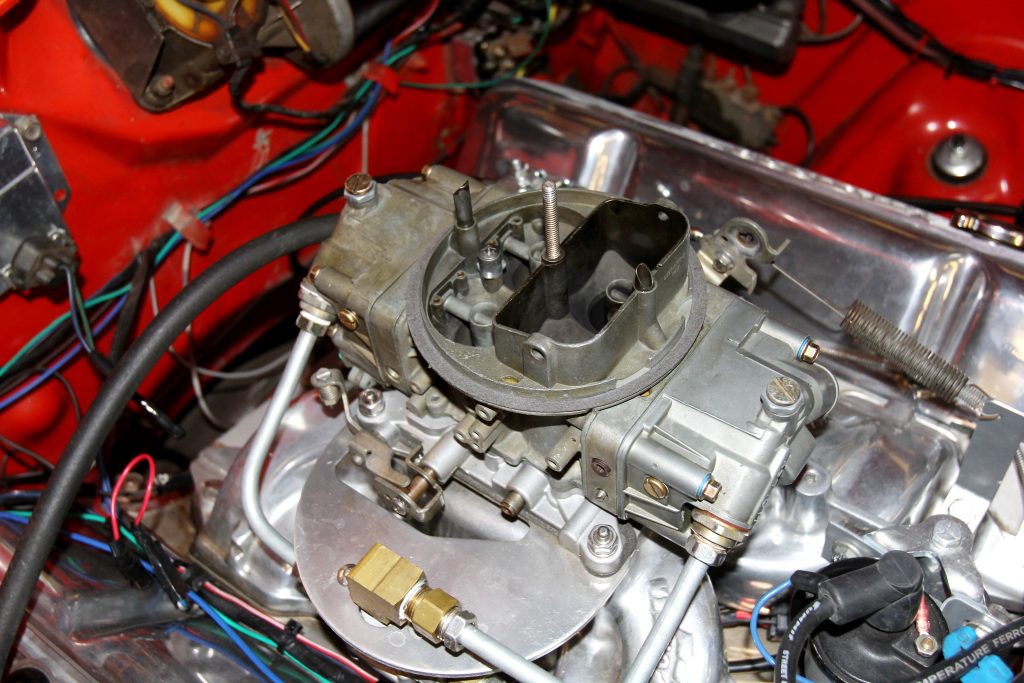I recently bought this 454 big block Chevy-powered Chevelle from a guy. When I test drove the car, the previous owner said the carb was jetted a little too rich but that it ran fine. Now that I have the car back in my garage, I noticed that the whole inside of the carburetor is coated with a nasty black residue that is also on the bottom side of the air cleaner lid. I’ve been told this is from backfiring but the engine has never backfired since I’ve owned it. The engine idles very rich and its stinky. Is there a fix for this?
B.W.
***
It’s been a few years since we’ve seen this but many years ago we had a small block that exhibited this same black, oily coating inside the carburetor and on the inside lid of the air cleaner. We eventually learned this was not from engine backfires, because we’d clean the residue but it would return within a few hundred miles of street driving and never once backfired through the intake.
Cam Overlap, a Rich Mixture & Intake Manifold Reversion?
Instead we learned that the camshaft was an old grind and it suffered from intake manifold reversion. This is where there was excessive overlap in the camshaft combined with an overly rich idle mixture. What occurs is that the intake opens too soon combined with a poor exhaust port or valve job. This poor exhaust system does not allow the combustion chamber to properly push out all the exhaust residue before the intake valve opens.
When this occurs, the exhaust gas pressure in the chamber is greater than the inlet pressure and when the intake valve opens, the exhaust gas travels back up into the intake manifold. If you remove the carburetor and look inside the intake manifold, you will see an even thicker and blacker residue on the inside of the plenum and intake ports.
When this happens, the engine will only idle with a rich idle mixture to compensate for the exhaust gas in the chamber, which is eventually pulled back into the cylinder during the inlet stroke. This exhaust gas will not burn again, which drastically reduces cylinder pressure. This results in a poor combustion performance at idle and part throttle—which only contributes to more exhaust gas finding its way back into the intake portion the next four-stroke cycle.
This situation is often exacerbated or made worse with older combustion chambers or engines with poor quench where there is too much room between the quench side of the piston and the combustion chamber on a wedge style heads.

Another issue may also be weak or too-cold spark plugs that tend to foul pretty quickly on the street. We’ve seen big blocks fitted with small block spark plugs where the threaded portion is too short which shrouds the plug and makes it perform poorly. This is an easy fix with just the addition of the right spark plug reach and the proper heat range.
This black soot mainly occurs when the engine is equipped with an older, poorly designed camshaft where the intake opens too early or the exhaust valve closes too late. Often these older cams used slow opening ramps with long duration and a ton of overlap. Newer cams tend to use opening and closing points that are more aggressive which means the cam profile opens the intake valve more quickly so the opening point can be delayed which reduces the overlap between the intake an exhaust.
How to Check & Fix It
We would suggest first checking the initial timing, adding fresh, standard heat range spark plugs, good spark plug wires, and a properly tuned carburetor. Set the idle mixture and initial timing to the highest idle vacuum possible. Change the oil and oil filter, and see if the engine responds to tuning.
You can also dribble 8 to 10 ounces of fresh, clean water down the carburetor with the engine at a fast idle to steam-clean some of the carbon that is likely built up inside the combustion chambers. Do this before you add the fresh spark plugs and see if this helps.
This article may be handy too: Can Seafoam Motor Treatment Clean an Engine’s Combustion Chamber?
You might also perform a compression check when the plugs are out to make sure all cylinders are contributing. Clean the carburetor and see if the residue returns after 50 to 100 street miles. If it does then likely the engine will need a more modern performance camshaft to solve the problem. Another clue that the cam is weak if the compression check delivers low cranking compression numbers. A typical big block should deliver 165 to 185 psi. If your cranking numbers are low at around 140 psi or less, this might e due to the camshaft installed too retarded.
Of course, there could be many other reasons for this but it’s a good place to start.
Hope this helps.

Comments